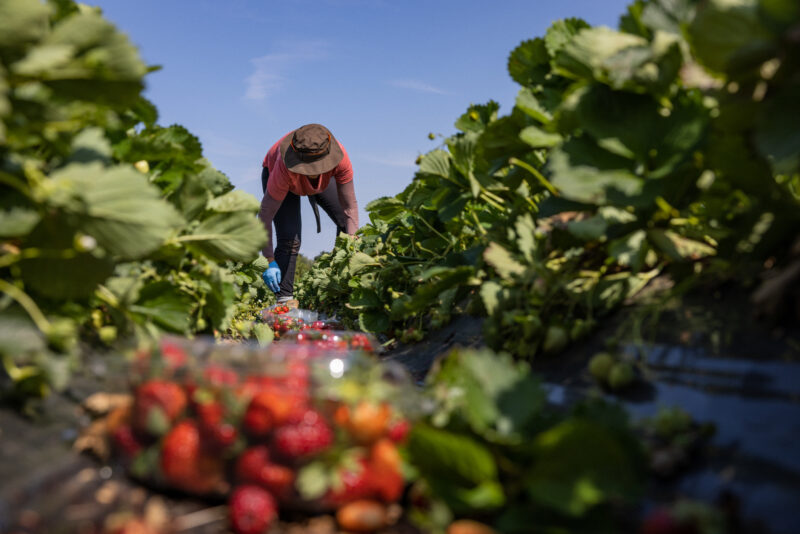
Migrant Farmworkers: A Catholic Perspective
June 2024
On many farms, orchards, and other agricultural sites across the U.S., stable and consistent access to annual or seasonal employees is limited due to lack of native-born locally based employees, competition from other industries, and low wages or wage fluctuations.
We live in a world in which conflicts, natural disasters, or more simply the impossibility of living a dignified and prosperous life in one’s native land compels millions of people to leave and seek work elsewhere in the world. This is usually the case for many migrant farmworkers who are in their search of a better future, for themselves and their family.
Migrant farmworkers undertake all manner of duties in a variety of locations including agricultural farms, fruit orchards, berry fields, dairy farms, product packing warehouses and other facilities. During the COVID-19 pandemic, farmworkers were deemed as “essential workers.” In a report highlighting the role of essential works in the states, The National Conference of State Legislatures noted that “essential workers are those who conduct a range of operations and services that are typically essential to continue critical infrastructure operations”, which includes agricultural industry.
In the United States, there are two types of migrant farmworkers. There are U.S.-based and legal permanent residents who travel to different regions or states to work on farms and agricultural sites, and there are H-2A temporary agricultural workers who come to the U.S. to work in, mostly, seasonal jobs in this country.
The H-2A Program and Its Results
The H-2A program was created in 1986 to bring nonimmigrant foreign workers to the U.S. to perform agricultural labor. With the decrease of domestic farm workers over nearly four decades, the number of foreign workers participating in the H-2A program has grown steadily.
In Fiscal Year 2021, the U.S. Department of Labor certified that 317,000 jobs were available through the H-2A visa program and 258,000 of the visas were issued. That year, 99% of the H-2A visas went to citizens of four countries: Mexico (93%), South Africa (3%), Jamaica (2%), and Guatemala (1%), and over half of the total H-2A jobs were in five states: California, Florida, Georgia, North Carolina, and Washington. In contrast, the number U.S.-based farmworkers from 2017 to 2022 dropped nationally by 14%. For one of the five states noted above, Washington, the decrease was 37% over the same period.
U.S. Department of Labor regulations for the program require employers “to certify that there are not sufficient U.S. workers” available to perform the work before they can hire H-2A workers. H-2A visas for farmworkers are valid for 10 months or less, and the payrate must be the same for H-2A workers as U.S.-based workers. Additionally, the employer must provide free housing to workers and the housing provided must meet minimum federal standards. Also, the employer must either provide three meals a day to each of the H-2A workers or furnish free and convenient cooking and kitchen facilities for workers to prepare and cook their own meals.
What is the Problem?
Advocates for domestic farmworkers argue that H-2A workers crowd out workers already in the U.S. while undercutting U.S. workers on hours worked and pay. U.S-based workers must also consider other factors that could hurt their ability to work, for example picking up a child from daycare or staying home to care for a sick family member. Those examples will result in lost pay and could result in lost contracts in the next year or being let go early as the harvest season tapers off. Since H-2A workers are brought in without families, they do not have the same needs as domestic workers. Advocates say employers take advantage of this distinction to hire more H-2A workers.
Growers and employers of H-2A workers defend the program and use it because of the assurance of a stable workforce without having to deal with the associated costs that occur with competing labor needs, market forces, and fluctuations in the prices of agricultural commodities. Also, since H2-A employees serve annual contracts, employers with year-round labor requirements have those met especially in seasons when the need for agricultural workers is high.
How Can this Aspect of the U.S. Immigration be Improved?
Recognizing the dignity of work of farmworkers is a central concern of the Catholic Church. In his 1981 encyclical, Laborem Exercems, Pope John Paul II spoke of the importance of agricultural workers and the need to protect those working in the fields [#21].
Farmworkers produce the food that we eat and contribute to the care of our community. Regarding immigrant farmworkers, the bishops in the U.S. have long advocated for reforms of the existing system, including a legalization program that would help stabilize the workforce, protect migrant workers, and their families from discrimination and exploitation and ensure that these workers are able to continue to make contributions to society.
The Farm Workforce Modernization Act (FWMA), which was passed on a bipartisan basis by the U.S. House of Representatives in 2021, would make changes to the H-2A program to provide more flexibility for employers, while ensuring critical protections for workers, and legalize farm workers and include an eventual path to U.S. citizenship. It has been estimated that 2.4 million farmworkers could benefit from the legislation. The USCCB has supported the FMWA.
Legislation such as the Farm Workforce Modernization Act propose a meaningful way for migrant agricultural workers to earn legal status through continued agricultural employment and contributions to the U.S. agricultural economy. It also improves labor protections while producing employment flexibility that is needed to aid our agricultural industries. Moreover, it creates more accessible and predictable worker programs while ensuring more worker protections, such as improving the availability of farmworker housing and providing better health protections.
